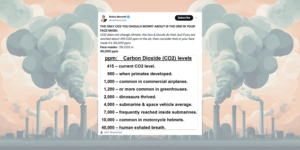Physical Address
23,24,25 & 26, 2nd Floor, Software Technology Park India, Opp: Garware Stadium,MIDC, Chikalthana, Aurangabad, Maharashtra – 431001 India
Physical Address
23,24,25 & 26, 2nd Floor, Software Technology Park India, Opp: Garware Stadium,MIDC, Chikalthana, Aurangabad, Maharashtra – 431001 India

By Vivek Saini
Claim 1: CO2 does not change climate; the sun and clouds do that.
Fact 1: The claim that CO2 does not change the climate is incorrect. Scientific consensus supports that increased levels of carbon dioxide and other greenhouse gasses in the atmosphere contribute to global warming and climate change. This is well-documented by climate scientists and supported by extensive research.
Claim 2: The concentration of CO2 in our face masks is 30,000 ppm.
Fact 2: While wearing a face mask can lead to a slight increase in the concentration of CO2 in the air you breathe within the mask, the levels are nowhere near 30,000 ppm (parts per million). In most cases, the CO2 concentration within a mask remains within safe and breathable limits, typically below 1,000 ppm.
Claim post:
What does the post say
In a viral X post, filmmaker Robin Monotti stated that the only CO2 we should worry about is the one in our face masks. He claimed that the sun and clouds are responsible for climate change, not CO2. He also claimed that face masks have very high concentrations of CO2, which is 30,000 ppm. He also posted a photo in which different concentrations of CO2 were provided for different environments.
What we found
The claim that CO2 does not change the climate is incorrect. Scientific consensus supports that increased levels of carbon dioxide and other greenhouse gasses in the atmosphere contribute to global warming and climate change. This is well-documented by climate scientists and supported by extensive research.
The other claim that the concentration of CO2 in face masks is 30,000 ppm (parts per million) seems extremely high and potentially dangerous. Wearing a face mask may result in a minor increase in the concentration of carbon dioxide (CO2) in the air you breathe within the mask. However, it’s important to emphasize that these elevated CO2 levels are nowhere near the 30,000 parts per million (ppm) threshold that might be of concern. In the majority of cases, the CO2 concentration within a mask remains well within safe and breathable limits, typically staying below 1,000 ppm. This indicates that using masks while causing a slight rise in CO2 doesn’t pose a significant risk to one’s health as the levels are comfortably within acceptable parameters for respiration.
The figures provided in the post for CO2 levels in different environments are generally accurate. However, the context is essential. High CO2 levels in spaces like submarines or greenhouses are managed and controlled to ensure safety and optimal conditions for the specific purpose.
Concentration of Carbon dioxide in our face masks
The widespread use of face masks has become common during the COVID-19 pandemic due to recommendations by public health officials. Studies have shown that masks reduce the transmission of SARS-CoV-2. However, this recommendation has stirred controversy in some countries, as concerns arose not only about mask fit but also about the potential rebreathing of carbon dioxide (CO2) from the mask. CO2 is a natural by-product of respiration, colorless and odorless, and in regular room air, its levels are around 0.03–0.04%, equivalent to 300–400 parts per million (ppm), with no known toxic effects.
According to a study published in BioMed Central, there is a noticeable increase in CO2 concentrations when routinely using face masks. However, these elevated levels still fall within the NIOSH (National Institute for Occupational Safety and Health) limits for short-term use. Therefore, there shouldn’t be significant concern about their regular daily use by healthcare providers. However, the potential clinical implications of prolonged face mask use and its impact on CO2 levels require further research. Powered Air-Purifying Respirators (PAPR) can help prevent relative hypercapnia (high carbon dioxide levels in blood).
CO2 and climate change
The Earth’s temperature is determined by the equilibrium between incoming and outgoing energy within the planet’s system. When sunlight reaches the Earth’s surface, it can be reflected into space or absorbed by the Earth. The energy absorbed by the Earth heats it. After absorption, the Earth emits some of this energy into the atmosphere as heat, also known as infrared radiation. Solar energy reflected in space does not contribute to the Earth’s warming.
There are specific gasses in the atmosphere that trap energy, slowing down or preventing heat loss to space. These gases are referred to as “greenhouse gasses.” They act like a cover, making the Earth’s temperature higher than it would naturally be. This process, commonly called the “greenhouse effect,” is a natural phenomenon. However, the recent accumulation of greenhouse gasses in the atmosphere due to human activities has altered the Earth’s climate and adversely affected human health, well-being, and ecosystems.
Key Greenhouse gasses:
Human emissions of greenhouse gases have primarily contributed to the warming observed since 1950. These emissions result from various human activities, such as the combustion of fossil fuels for heat and energy, deforestation, the application of fertilizers in agriculture, waste disposal in landfills, livestock farming, and the manufacturing of certain industrial products.
If you have any queries or come across suspicious content related to climate change or the environment and want us to verify them, send them to Climate Buddy, our WhatsApp tipline +91 70453 66366.
References: